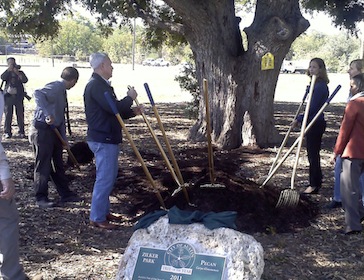
Austin Mayor Lee Leffingwell joins Arbor Day celebrants spreading mulch under a 130-year-old pecan tree in the city's Zilker Park
AUSTIN — At Austin’s 20th Annual Arbor Day observance in October, the drought took center stage. The tree of the year, a 130-year-old pecan, rose behind the stage erected in Zilker Park for the ceremony. It and other nearby trees were labeled with dollar values that reflected their worth in terms of cleaner air through carbon dioxide reduction. The tree of the year had an estimated value of $10,000.
Mayor Lee Leffingwell and other guests tossed mulch around the big pecan. A work party would spend the rest of the day mulching all the trees in the park, one way to help keep them healthy during the dry spell. Michael Embesi, the city’s arborist, threw a shovelful.
“We’ve lost a lot of trees during this unprecedented drought,” he said. “Fortunately, many trees have shown to be resilient.”
Last year’s drought has been rough on trees throughout Texas. In parts of West Texas and the western Hill Country, entire hillsides of juniper have died. Last fall, state climatologist John Nielsen-Gammon said the drought could last another decade, meaning that tree owners will have to be vigilant to keep some species healthy. Recent rains have given trees a respite, but haven’t changed the long-term outlook.
[TCN editor’s update: Since this article first appeared in Reporting Texas, additional rains have ended the drought in parts of Texas. But in the latest U.S. Seasonal Drought Outlook, issued on March 1, federal climate experts said they expect drought to “persist or intensify” in most of the state through May, though with “some improvement” in East Texas. In February, Nielsen-Gammon told a water forum on drought preparedness in Austin to expect continued “water supply issues across most of the state through summer,” with sea-surface temperature patterns then favoring drought for several more years and the “ever-increasing temperatures” brought by climate change increasing evaporation.]
“Many of the [tree] species that are new around here from a geologic time frame are not acclimated well enough to this environment and have perished due to this long drought,” said Nickey Bishop, a certified arborist and owner and operator of The Tree Tender in Austin. “This drought is basically weeding out the inferior species that perish when the rare extremes come along.”
Bishop cited a 100-year-old live oak, a native species, in his front yard as weathering the drought better than a number of invasive species he encounters on the job, such as chinaberry trees or bamboo stalks.
Texas red oaks are highly susceptible to drought, while live oaks and white oaks are better adapted and require less water, according to the Texas Forest Service. The service lists native trees such as pecans, cedar elms and bur oaks as well adapted to drought. They have to be in the right places, though, or they can be in danger, too.
Native pecans, for example, grow naturally in creek beds and other well-watered areas.
“The trees that are suffering most are those that are somewhat misplaced, like pecans,” Embesi said. “People commonly plant pecans in their yards in Austin, but yards don’t receive the same amount of water as riparian areas that get storm water runoff.” Embesi said people should realize that even native trees such as the pecan grow well only under the right conditions.
According to Wayne K. Clatterbuck, an associate professor of forestry, wildlife and fisheries at the University of Tennessee, drought-tolerant trees have certain traits in common. Trees with small leaves are more easily cooled and use water more efficiently than trees with larger leaves. Upland species—those that grow on drier soil above watercourses—are usually more drought-resistant than bottomland species. Trees with deep, upright crowns loose less water to evaporation than those with flat, wide-spreading crowns. Drought-tolerant plants usually have thick leaf wax and bark.
Since the drought started, Bishop said, his business has skyrocketed. He’s meeting regularly with neighborhood associations and other groups to educate people on caring for trees during a drought and dispelling inaccurate information sometimes picked up on the Internet. One myth is that you can water a tree near its trunk. “The bigger the tree, the farther away you have to be,” Bishop said. “Trees don’t eat or drink near the trunk.”
John Burns, landscape manager at the University of Texas, says all trees on campus have suffered during the drought. “We … have had five different trucks with water tanks going, almost constantly soaking trees,” Burns said. “If you lose a shrub, it costs a few dollars to replace it; if you lose a tree, it’s 50 years of growth—it’s really irreplaceable.”
– Ari Phillips for Reporting Texas
+++++
Reporting Texas is a digital media initiative from the School of Journalism at the University of Texas at Austin. It accepts submissions from undergraduate and graduate students throughout the university, promoting engagement in the digital age of journalism.
